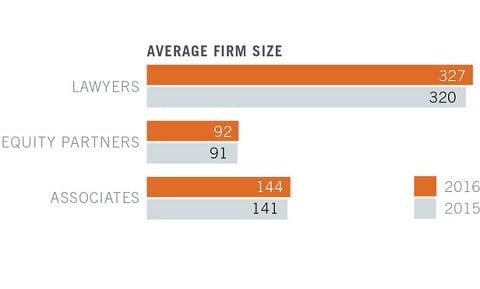The 2017 NLJ 500: ranking America's 500 largest law firms
Which are the biggest US law firms by headcount? And which have the biggest presence in the top five cities?
June 30, 2017 at 05:28 AM
4 minute read
The NLJ 500 is the National Law Journal's annual survey of the 500 largest law firms in the US. Click here for full coverage.
 The largest law firms appear to be getting smarter about what size they want to be.
The largest law firms appear to be getting smarter about what size they want to be.
In a world where size and growth is a near-obsession at some firms, many have continued to grow at a rate that is more volatile than the statistics suggest. And inversely, some of the biggest firms have decreased their footprints in a noticeable way.
That amount of movement is not always captured in industry averages. Overall, the number of lawyers last year who work at the 500 largest US law firms increased by about 2% to 163,700. The average firm size was 327 lawyers, up a hair from 320 the year before.
In comparison, only a handful of firms among the top 20 changed their size by less than 2%.
Law firm consultant Miriam Herman, who regularly advises major firms on global growth, called the phenomenon "continuous recalibration".
"Savvy firms will be adding and shedding consistent with a strategy geared to the particulars of their practice, client and geographic strengths," she added.
 Baker McKenzie, the largest US-centered law firm in the NLJ 500, grew almost 6%. That change in size came without the firm completing a merger or opening a new office.
Baker McKenzie, the largest US-centered law firm in the NLJ 500, grew almost 6%. That change in size came without the firm completing a merger or opening a new office.
DLA Piper, the second largest firm in the survey, saw headcount decline by 4%, even in a year it acquired three small firms in Sweden, Finland and Canada.
In the two greatest swings among the 20 largest firms, Lewis Brisbois Bisgaard & Smith grew by almost 12%, while Reed Smith shrank by more than 5%. (Dentons, which is based in the US and claims to be the world's largest firm, is not included in the NLJ 500 survey because it has more lawyers in China than in the US.)
Michael Wagner, Baker McKenzie's chair for North America, said that programmes at his firm that focus more on client relationships, feedback and certain industries allow for more targeted lawyer recruitment.
At the geographic level, Bakers added the most lawyers to its Sao Paulo office last year, for an addition of 50, or more than 30% growth. The office now has almost 200 lawyers. Wagner noted how the firm is leading compliance and investigations work for several clients in Brazil, including JBS, a meat processing company facing a bribery investigation.
"No one wants to slip in their market ranking. [But] our focus is on the clients, not on the prestige, not on the reach and so forth," Wagner said. "We're just targeting our investments to things clients tell us in the market to do."
Roger Meltzer, global co-chairman of DLA Piper, called his firm's loss of lawyers in 2016 a "result of natural attrition and the constant reshaping of our professional workforce".
Even Texas firm Jackson Walker – which had 347 lawyers and 2.8% growth last year, making it a quintessentially average firm in our survey – has taken on a nuanced approach to firm size.
"We continue to believe we're in a slice of the market where we can continue to grow," said managing partner Wade Cooper. "We don't have ambition to grow outside the state."
The firm decided it was comfortable being a regional firm, and could find laterals from both national practices and locally. Jackson Walker hopes to continue to grow, but Cooper said he's not interested in doing so the classic way, via merger.
"Since our last strategic plan, my instructions are not to entertain any [merger] conversations," Cooper said.
This content has been archived. It is available through our partners, LexisNexis® and Bloomberg Law.
To view this content, please continue to their sites.
Not a Lexis Subscriber?
Subscribe Now
Not a Bloomberg Law Subscriber?
Subscribe Now
NOT FOR REPRINT
© 2025 ALM Global, LLC, All Rights Reserved. Request academic re-use from www.copyright.com. All other uses, submit a request to [email protected]. For more information visit Asset & Logo Licensing.
You Might Like
View All

A&O Shearman Exits Continue as New York Partner Joins Cleary

Clyde & Co Launches Office in Texas Through Combination With Dallas Insurance Boutique
2 minute readTrending Stories
- 1'It's Not Going to Be Pretty': PayPal, Capital One Face Novel Class Actions Over 'Poaching' Commissions Owed Influencers
- 211th Circuit Rejects Trump's Emergency Request as DOJ Prepares to Release Special Counsel's Final Report
- 3Supreme Court Takes Up Challenge to ACA Task Force
- 4'Tragedy of Unspeakable Proportions:' Could Edison, DWP, Face Lawsuits Over LA Wildfires?
- 5Meta Pulls Plug on DEI Programs
Who Got The Work
Michael G. Bongiorno, Andrew Scott Dulberg and Elizabeth E. Driscoll from Wilmer Cutler Pickering Hale and Dorr have stepped in to represent Symbotic Inc., an A.I.-enabled technology platform that focuses on increasing supply chain efficiency, and other defendants in a pending shareholder derivative lawsuit. The case, filed Oct. 2 in Massachusetts District Court by the Brown Law Firm on behalf of Stephen Austen, accuses certain officers and directors of misleading investors in regard to Symbotic's potential for margin growth by failing to disclose that the company was not equipped to timely deploy its systems or manage expenses through project delays. The case, assigned to U.S. District Judge Nathaniel M. Gorton, is 1:24-cv-12522, Austen v. Cohen et al.
Who Got The Work
Edmund Polubinski and Marie Killmond of Davis Polk & Wardwell have entered appearances for data platform software development company MongoDB and other defendants in a pending shareholder derivative lawsuit. The action, filed Oct. 7 in New York Southern District Court by the Brown Law Firm, accuses the company's directors and/or officers of falsely expressing confidence in the company’s restructuring of its sales incentive plan and downplaying the severity of decreases in its upfront commitments. The case is 1:24-cv-07594, Roy v. Ittycheria et al.
Who Got The Work
Amy O. Bruchs and Kurt F. Ellison of Michael Best & Friedrich have entered appearances for Epic Systems Corp. in a pending employment discrimination lawsuit. The suit was filed Sept. 7 in Wisconsin Western District Court by Levine Eisberner LLC and Siri & Glimstad on behalf of a project manager who claims that he was wrongfully terminated after applying for a religious exemption to the defendant's COVID-19 vaccine mandate. The case, assigned to U.S. Magistrate Judge Anita Marie Boor, is 3:24-cv-00630, Secker, Nathan v. Epic Systems Corporation.
Who Got The Work
David X. Sullivan, Thomas J. Finn and Gregory A. Hall from McCarter & English have entered appearances for Sunrun Installation Services in a pending civil rights lawsuit. The complaint was filed Sept. 4 in Connecticut District Court by attorney Robert M. Berke on behalf of former employee George Edward Steins, who was arrested and charged with employing an unregistered home improvement salesperson. The complaint alleges that had Sunrun informed the Connecticut Department of Consumer Protection that the plaintiff's employment had ended in 2017 and that he no longer held Sunrun's home improvement contractor license, he would not have been hit with charges, which were dismissed in May 2024. The case, assigned to U.S. District Judge Jeffrey A. Meyer, is 3:24-cv-01423, Steins v. Sunrun, Inc. et al.
Who Got The Work
Greenberg Traurig shareholder Joshua L. Raskin has entered an appearance for boohoo.com UK Ltd. in a pending patent infringement lawsuit. The suit, filed Sept. 3 in Texas Eastern District Court by Rozier Hardt McDonough on behalf of Alto Dynamics, asserts five patents related to an online shopping platform. The case, assigned to U.S. District Judge Rodney Gilstrap, is 2:24-cv-00719, Alto Dynamics, LLC v. boohoo.com UK Limited.
Featured Firms
Law Offices of Gary Martin Hays & Associates, P.C.
(470) 294-1674
Law Offices of Mark E. Salomone
(857) 444-6468
Smith & Hassler
(713) 739-1250









